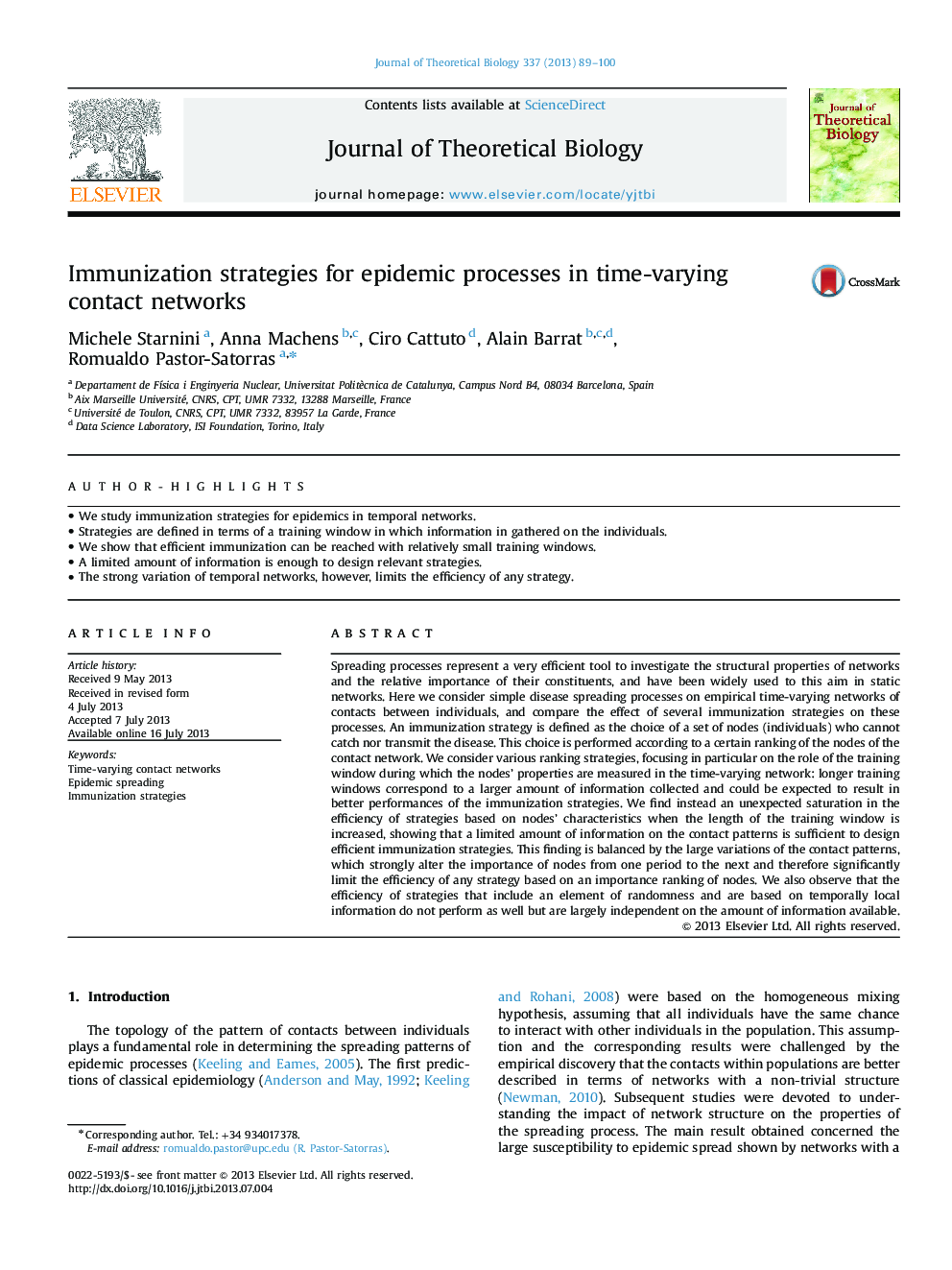| کد مقاله | کد نشریه | سال انتشار | مقاله انگلیسی | نسخه تمام متن |
|---|---|---|---|---|
| 6370769 | 1623873 | 2013 | 12 صفحه PDF | دانلود رایگان |
عنوان انگلیسی مقاله ISI
Immunization strategies for epidemic processes in time-varying contact networks
ترجمه فارسی عنوان
استراتژی های ایمن سازی برای پروسه های اپیدمی در شبکه های مختلف تماس متناوب
دانلود مقاله + سفارش ترجمه
دانلود مقاله ISI انگلیسی
رایگان برای ایرانیان
کلمات کلیدی
شبکه های تماس متنوع متغیر، گسترش اپیدمی، استراتژی های ایمن سازی،
ترجمه چکیده
فرآیندهای توزیع نشان دهنده ابزار بسیار کارآمد برای بررسی خواص ساختاری شبکه ها و اهمیت نسبی اجزای آنها هستند و در شبکه های استاتیک به طور گسترده ای مورد استفاده قرار گرفته اند. در اینجا ما پروسه های گسترش بیماری های ساده را در شبکه های مختلف تجربی مختلف ارتباطات بین افراد در نظر می گیریم و مقایسه چندین راهبرد واکسیناسیون را در این فرآیندها مقایسه می کنیم. یک استراتژی ایمن سازی به عنوان انتخاب مجموعه ای از گره ها (افراد) تعریف می شود که قادر به گرفتن و انتقال بیماری نیستند. این انتخاب با توجه به رتبه بندی خاص گره های شبکه تماس انجام می شود. ما در نظر استراتژی های مختلف رتبه بندی، با تمرکز خاص بر نقش پنجره آموزش که در آن خواص گره در شبکه زمان متغیر اندازه گیری می شود: پنجره های آموزش بیشتر مطابق با مقدار بیشتری از اطلاعات جمع آوری شده و می تواند انتظار می رود که در نتیجه بهتر اجرای استراتژی های ایمن سازی. ما در عوض یک اشباع غیر منتظره در کارایی استراتژی مبتنی بر ویژگی های گره ها زمانی که طول پنجره آموزش افزایش می یابد، نشان می دهد که مقدار محدودی از اطلاعات مربوط به الگوهای تماس برای طراحی راهبردهای ایمن سازی موثر کافی است. این یافته با تنوع زیادی از الگوهای تماس، که به شدت اهمیت گره ها را از یک دوره به بعد تغییر می دهد متعادل می شود و بنابراین کارایی هر استراتژی را بر اساس رتبه بندی اهمیت گره محدود می کند. ما همچنین مشاهده می کنیم که کارایی استراتژی هایی که شامل عنصر تصادفی هستند و براساس اطلاعات موقت محلی انجام نمی شود، بلکه به میزان قابل توجهی در میزان اطلاعات موجود به طور مستقل است.
موضوعات مرتبط
علوم زیستی و بیوفناوری
علوم کشاورزی و بیولوژیک
علوم کشاورزی و بیولوژیک (عمومی)
چکیده انگلیسی
Spreading processes represent a very efficient tool to investigate the structural properties of networks and the relative importance of their constituents, and have been widely used to this aim in static networks. Here we consider simple disease spreading processes on empirical time-varying networks of contacts between individuals, and compare the effect of several immunization strategies on these processes. An immunization strategy is defined as the choice of a set of nodes (individuals) who cannot catch nor transmit the disease. This choice is performed according to a certain ranking of the nodes of the contact network. We consider various ranking strategies, focusing in particular on the role of the training window during which the nodes' properties are measured in the time-varying network: longer training windows correspond to a larger amount of information collected and could be expected to result in better performances of the immunization strategies. We find instead an unexpected saturation in the efficiency of strategies based on nodes' characteristics when the length of the training window is increased, showing that a limited amount of information on the contact patterns is sufficient to design efficient immunization strategies. This finding is balanced by the large variations of the contact patterns, which strongly alter the importance of nodes from one period to the next and therefore significantly limit the efficiency of any strategy based on an importance ranking of nodes. We also observe that the efficiency of strategies that include an element of randomness and are based on temporally local information do not perform as well but are largely independent on the amount of information available.
ناشر
Database: Elsevier - ScienceDirect (ساینس دایرکت)
Journal: Journal of Theoretical Biology - Volume 337, 21 November 2013, Pages 89-100
Journal: Journal of Theoretical Biology - Volume 337, 21 November 2013, Pages 89-100
نویسندگان
Michele Starnini, Anna Machens, Ciro Cattuto, Alain Barrat, Romualdo Pastor-Satorras,
